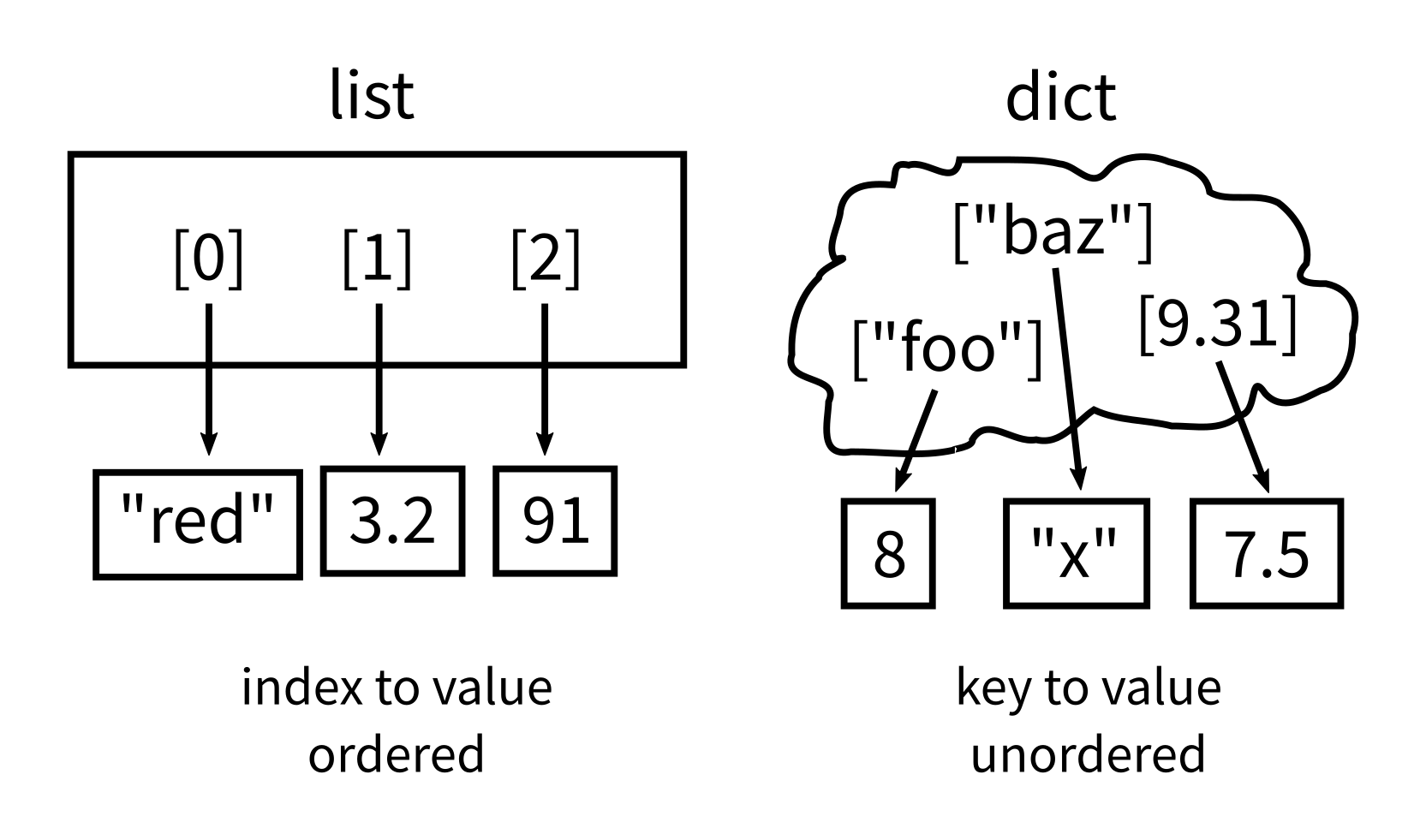Lecture 10
Dictionaries
MCS 260 Fall 2020
Emily Dumas
Reminders
- Work on:
- Project 1 (due Friday, 6pm central)
- Worksheet 4
- Quiz 4
- Docstrings now required for all functions & files
- Come to Tue/Thu discussion ready to share screen and code (if at all possible)
Dictionaries
Lists and tuples are sequences: they store an ordered collection of values that can be retrieved by index (a nonnegative integer).
A dictionary or dict in Python is an unordered collection of key:value pairs. Values can be retrieved using the associated key, similar to indexing a list.
The values in a dictionary can be of any type, but there are some restrictions on the keys.
Dictionaries are mutable.
Example of syntax for working with dictionaries:
>>> # define a new dict
>>> tuition = { "UIC": 10584,
... "Stanford": 50703,
... "Harvard": 46340 }
>>> # Access an item
>>> tuition["UIC"]
10584
>>> # Add or change an item
>>> tuition["PSU"] = 18454
>>> tuition
{'UIC': 10584,
'Stanford': 50703,
'Harvard': 46340,
'PSU': 18454}
>>> # Remove an item
>>> del tuition["Harvard"]
>>> tuition
{'UIC': 10584, 'Stanford': 50703, 'PSU': 18454}
Mixed types are ok for keys or values.
d = { 1: "fish", "two": "fish", "x": [7,6,5] }
Methods:
>>> d.keys() # All keys (like range(len(L)))
dict_keys([1, 'two', 'x'])
>>> d.items() # All key-value pairs (like enumerate(L))
dict_items([(1, 'fish'), ('two', 'fish'), ('x', [7, 6, 5])])
>>> d.values() # All values
dict_values(['fish', 'fish', [7, 6, 5]])
dict_keys, dict_items, dict_values types behave a lot like list, and can be converted to a list with $\texttt{list()}$.
Membership testing
Membership in a dictionary means being a key!
>>> d = { 1: "fish", "two": "fish", "x": [7,6,5] }
>>> "fish" in d
False
>>> 1 in d
True
Forgetting this is a very common source of programming errors.
Other languages
Python dicts are examples of associative arrays, also known as maps.
In other languages with a built-in associative array type, the type is often called map or Map (e.g. in C++, Java, Go)
The rules (allowable keys, type heterogeneity, etc.) vary by language.
Iteration over dicts
dicts are iterable, but iterate over the keys.
for k in d: # loop over keys
print(k,"is one of the keys")
for k in d: # loop over keys (index to get value)
print("Key",k,"has value",d[k])
for k,v in d.items(): # loop over keys,value pairs
print("Key",k,"has value",v)
It is common for the values in a dict to be dicts themselves. This is the usual way to make a collection of labeled data indexed by a key.
schooldata = {
"UIC": {
"fullname": "University of Illinois at Chicago",
"tuition": 10584,
"undergrad_students": 21641,
},
"Stanford": {
"fullname": "Leland Stanford Junior University",
"tuition": 50703,
"undergrad_students": 7083
},
"Harvard": {
"fullname": "Harvard University",
"tuition": 46340,
"undergrad_students": 6755
}
}
for shortname,data in schooldata.items():
print(shortname,"has annual tuition",data["tuition"])
Dictionaries as rules
pr_replacements = {
"accident": "unplanned event",
"escape": "departure",
"laser-sharks": "fish"
}
original = "an accident involving the escape of laser-sharks"
words = original.split() # [ "an", "accident", ... ]
for w in words:
if w in pr_replacements:
w = pr_replacements[w]
print(w,end=" ")
print()
an unplanned event involving the departure of fish
Hashable types
Not all types in Python can be used as dict keys.
>>> d = dict() # empty dict
>>> d[ [3,4,5] ] = 6
Traceback (most recent call last):
File "<stdin>", line 1, in <module>
TypeError: unhashable type: 'list'
>>> d[ { 5:"five" } ] = 0
Traceback (most recent call last):
File "<stdin>", line 1, in <module>
TypeError: unhashable type: 'dict'
Keys must allow hashing which typically requires immutability.
Strings, tuples, and numeric types are all hashable. Lists and dicts are not.
>>> hash(1)
1
>>> hash(1.5)
1152921504606846977
>>> hash("Granny Smith")
2634656644181978377
>>> hash( [1,2,3] )
Traceback (most recent call last):
File "<stdin>", line 1, in <module>
TypeError: unhashable type: 'list'
Dictionary comprehensions
Analogous to list comprehensions, but using $\texttt{ \{ key:value for name in iterable ... \} }$.
>>> words = [ "Chicago", "cat", "cinemas" ]
>>> word_data = { w: { "length": len(w),
... "all lower": w==w.lower() }
... for w in words }
>>> word_data
{'Chicago': {'length': 7, 'all lower': False},
'cat': {'length': 3, 'all lower': True},
'cinemas': {'length': 7, 'all lower': True}
}

References
Acknowledgement
- Some of today's lecture was based on teaching materials developed for MCS 260 by Jan Verschelde.
Revision history
- 2020-09-15 Initial publication